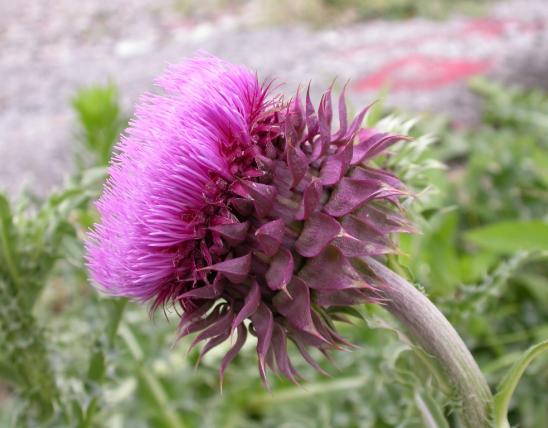
A weedy perennial forb with wide-spreading, horizontal, fibrous roots that can be 3 feet deep. The grooved, slender stems branch only at the top and are slightly hairy when young, becoming covered with hair as the plant grows. The oblong, tapering, stalkless leaves are deeply divided, with prickly margins. Leaves are green on both sides with a smooth or slightly downy lower surface. Blooms June through September. Flowers are rose-purple or white, and are smaller (¾ inch in diameter) and more numerous than for many other thistles. The flower heads are compact and appear on upper stems. Some plants have only female flowers; others have both male and combination (perfect) flowers. Seeds are small (³⁄₁₆ inch long), light brown, smooth and slightly tapered, with a tuft of tan hair loosely attached to the tip.
Similar species: Nine species of Cirsium have been recorded for our state. Some are native and uncommon. The three exotic invasive thistles all have leaves that are typically green on both sides, while leaves of natives usually have whitened and woolly undersides. Exotic thistles also tend to have heavily branched stems and more numerous flower heads per stem. Our native thistles are valuable members of our flora, providing food, habitat, and/or nesting materials for monarchs, goldfinches, and more.
Height: 2 to 5 feet.

Scattered throughout the northern two-thirds of Missouri, but potentially statewide.
Habitat and Conservation
Canada thistle does best in disturbed areas (overgrazed pastures, old fields, waste places, fence rows, along roadsides). It can occur in wet areas where water levels fluctuate (along stream banks and ditches). It can invade sedge meadows and wet prairies from nearby disturbed sites. This thistle is not usually found in undisturbed, high-quality prairies, good to excellent pastures, or in woodlands. In sites that are shaded most of the day, this plant grows tall and lax, with few flowers.
Status
Invasive. Native to Europe and Asia, it occurs nearly throughout the U.S. and Canada. In commonly occurs in patches in disturbed areas. Seeds are dispersed in the wind and by water running in ditches. The plants spread rapidly by rhizomes or root segments. Aerial shoots are sent up at 2-6 inch intervals. Basal leaves are produced the first year, and flowering stems the next. Pollination is mostly by honeybees. Wind pollination is limited.
Control
Human Connections
Like many U.S. weeds, this plant probably arrived as a contaminant in agricultural seed. Because of its deep, spreading roots, it is tough to control once established. A bane to farmers as well as to natural ecosystems, it has been considered a noxious weed in our state since 1909.
Ecosystem Connections
Canada thistle is a good nectar plant for bees and butterflies, and goldfinches eat the seeds. However, it is an invasive exotic weed that competes fiercely with native plants, and its presence degrades the native ecosystems it infests.


























